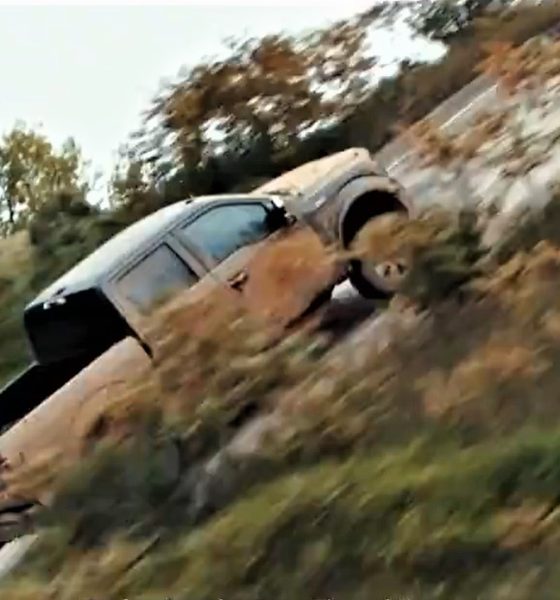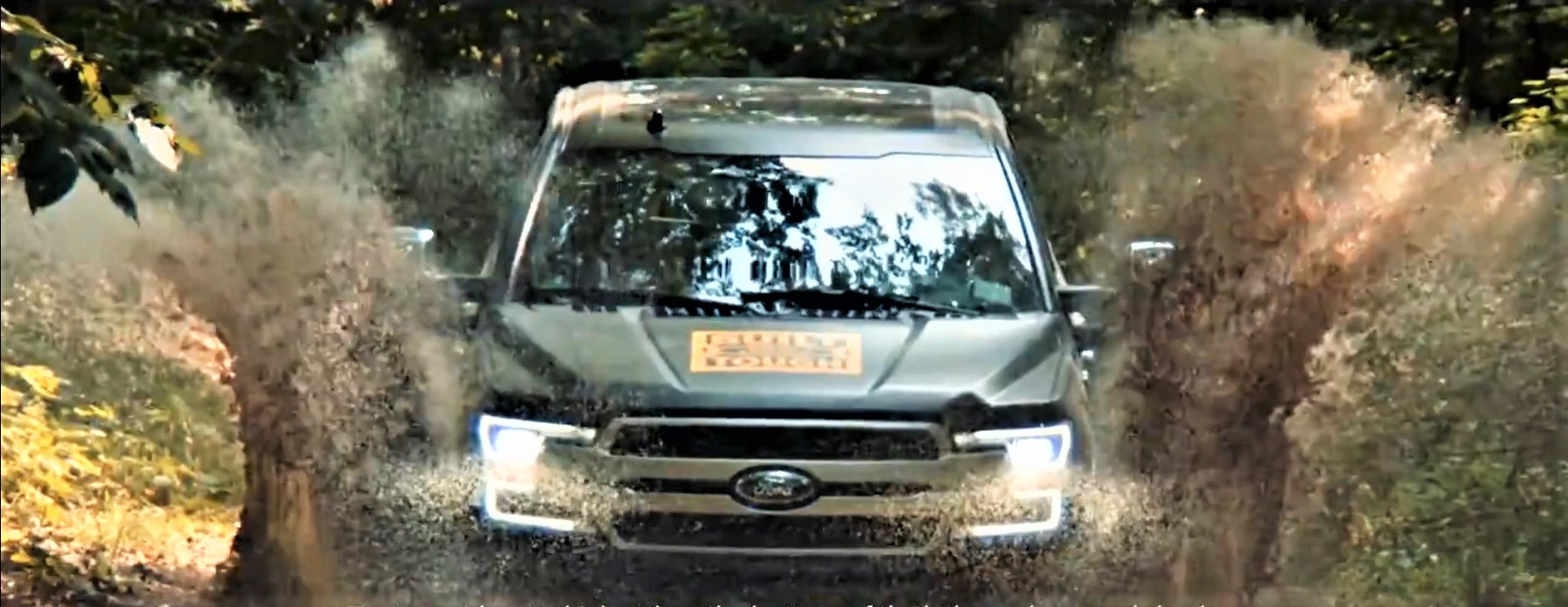

News
Ford follows up electric F-150 ‘real work truck’ claims with flashy teaser video
Just last week, a Ford Motors executive threw some shade at the upcoming Tesla Cybertruck and other manufacturer’s similar all-electric pursuits, claiming its competitors were producing ‘lifestyle’ trucks rather than ‘real’ work vehicles. In a follow up to those claims, the maker of America’s most popular pickup truck has released a flashy new video showing off their all-electric F-150 doing some tough, work-heavy action.
In the marketing bit, the company’s well-known “Built Ford Tough” motto is clearly used as the clip’s inspiration. The electric F-150 featured has the phrase on its hood, and the truck is seen handling environments meant to show off its capabilities. In particular, the vehicle travels up steep inclines with a large trailer in tow and easily commutes through large boulder-ridden trails. This recent video clearly indicates that Ford is not just serious about its EV commitment, but it intends to keep its crown in the American pickup segment.
In a media briefing on September 16th, Ford’s president of the Americas and international markets, Kumar Galhotra, highlighted that the upcoming electric F-150 would be built for heavy-duty hauling and towing. Ford won’t precisely aim for the recreation crowd, as its rivals Tesla and Rivian have supposedly done with their brands. “The all-electric F-150 is designed and engineered for hard-working customers that need a truck to do a job,” Galhotra explained.

Even with a 100-year-plus head start in terms of market presence, Ford will be delivering its first electric truck later than any of its newer peers. The American automaker expects the electric F-150 to be due around the middle of 2022. However, both Tesla and Rivian are planning trial production and customer deliveries in mid-2021. Notably, although Ford’s recent advertisement is meant to differentiate the legacy automaker from its rivals, even Rivian has put out videos already with the R1T pickup handling challenging environments similar to those taken up by the F-150.
Ford’s entry into the EV world may also be hindered by battery cell production – a problem that seems to be a recurring theme for most electric car companies. Due to a legal dispute between LG Chem and SK Innovation, the latter being the cell supplier for the battery-powered F-150, SK Innovation may be blocked from establishing a battery production facility in the US. This would most likely impact Ford’s ability to ramp production of its upcoming truck. Volkswagen is also affected by the SK Innovation legal hurdles.
With Tesla’s early start on electric vehicle production in 2012 combined with its most recent entry into battery cell production to be detailed at tomorrow’s Battery Day event, perhaps Ford will need to look a bit more towards its rivals to help navigate the future despite being such a leader in the past.
You can watch Ford’s new electric F-150 video below:

News
Tesla FSD fleet is nearing 7 billion total miles, including 2.5 billion city miles
As can be seen on Tesla’s official FSD webpage, vehicles equipped with the system have now navigated over 6.99 billion miles.

Tesla’s Full Self-Driving (Supervised) fleet is closing in on almost 7 billion total miles driven, as per data posted by the company on its official FSD webpage.
These figures hint at the massive scale of data fueling Tesla’s rapid FSD improvements, which have been quite notable as of late.
FSD mileage milestones
As can be seen on Tesla’s official FSD webpage, vehicles equipped with the system have now navigated over 6.99 billion miles. Tesla owner and avid FSD tester Whole Mars Catalog also shared a screenshot indicating that from the nearly 7 billion miles traveled by the FSD fleet, more than 2.5 billion miles were driven inside cities.
City miles are particularly valuable for complex urban scenarios like unprotected turns, pedestrian interactions, and traffic lights. This is also the difference-maker for FSD, as only complex solutions, such as Waymo’s self-driving taxis, operate similarly on inner-city streets. And even then, incidents such as the San Francisco blackouts have proven challenging for sensor-rich vehicles like Waymos.
Tesla’s data edge
Tesla has a number of advantages in the autonomous vehicle sector, one of which is the size of its fleet and the number of vehicles training FSD on real-world roads. Tesla’s nearly 7 billion FSD miles then allow the company to roll out updates that make its vehicles behave like they are being driven by experienced drivers, even if they are operating on their own.
So notable are Tesla’s improvements to FSD that NVIDIA Director of Robotics Jim Fan, after experiencing FSD v14, noted that the system is the first AI that passes what he described as a “Physical Turing Test.”
“Despite knowing exactly how robot learning works, I still find it magical watching the steering wheel turn by itself. First it feels surreal, next it becomes routine. Then, like the smartphone, taking it away actively hurts. This is how humanity gets rewired and glued to god-like technologies,” Fan wrote in a post on X.
News
Tesla starts showing how FSD will change lives in Europe
Local officials tested the system on narrow country roads and were impressed by FSD’s smooth, human-like driving, with some calling the service a game-changer for everyday life in areas that are far from urban centers.

Tesla has launched Europe’s first public shuttle service using Full Self-Driving (Supervised) in the rural Eifelkreis Bitburg-Prüm region of Germany, demonstrating how the technology can restore independence and mobility for people who struggle with limited transport options.
Local officials tested the system on narrow country roads and were impressed by FSD’s smooth, human-like driving, with some calling the service a game-changer for everyday life in areas that are far from urban centers.
Officials see real impact on rural residents
Arzfeld Mayor Johannes Kuhl and District Administrator Andreas Kruppert personally tested the Tesla shuttle service. This allowed them to see just how well FSD navigated winding lanes and rural roads confidently. Kruppert said, “Autonomous driving sounds like science fiction to many, but we simply see here that it works totally well in rural regions too.” Kuhl, for his part, also noted that FSD “feels like a very experienced driver.”
The pilot complements the area’s “Citizen Bus” program, which provides on-demand rides for elderly residents who can no longer drive themselves. Tesla Europe shared a video of a demonstration of the service, highlighting how FSD gives people their freedom back, even in places where public transport is not as prevalent.
What the Ministry for Economic Affairs and Transport says
Rhineland-Palatinate’s Minister Daniela Schmitt supported the project, praising the collaboration that made this “first of its kind in Europe” possible. As per the ministry, the rural rollout for the service shows FSD’s potential beyond major cities, and it delivers tangible benefits like grocery runs, doctor visits, and social connections for isolated residents.
“Reliable and flexible mobility is especially vital in rural areas. With the launch of a shuttle service using self-driving vehicles (FSD supervised) by Tesla in the Eifelkreis Bitburg-Prüm, an innovative pilot project is now getting underway that complements local community bus services. It is the first project of its kind in Europe.
“The result is a real gain for rural mobility: greater accessibility, more flexibility and tangible benefits for everyday life. A strong signal for innovation, cooperation and future-oriented mobility beyond urban centers,” the ministry wrote in a LinkedIn post.
News
Tesla China quietly posts Robotaxi-related job listing
Tesla China is currently seeking a Low Voltage Electrical Engineer to work on circuit board design for the company’s autonomous vehicles.

Tesla has posted a new job listing in Shanghai explicitly tied to its Robotaxi program, fueling speculation that the company is preparing to launch its dedicated autonomous ride-hailing service in China.
As noted in the listing, Tesla China is currently seeking a Low Voltage Electrical Engineer to work on circuit board design for the company’s autonomous vehicles.
Robotaxi-specific role
The listing, which was shared on social media platform X by industry watcher @tslaming, suggested that Tesla China is looking to fill the role urgently. The job listing itself specifically mentions that the person hired for the role will be working on the Low Voltage Hardware team, which would design the circuit boards that would serve as the nervous system of the Robotaxi.
Key tasks for the role, as indicated in the job listing, include collaboration with PCB layout, firmware, mechanical, program management, and validation teams, among other responsibilities. The role is based in Shanghai.
China Robotaxi launch
China represents a massive potential market for robotaxis, with its dense urban centers and supportive policies in select cities. Tesla has limited permission to roll out FSD in the country, though despite this, its vehicles have been hailed as among the best in the market when it comes to autonomous features. So far, at least, it appears that China supports Tesla’s FSD and Robotaxi rollout.
This was hinted at in November, when Tesla brought the Cybercab to the 8th China International Import Expo (CIIE) in Shanghai, marking the first time that the autonomous two-seater was brought to the Asia-Pacific region. The vehicle, despite not having a release date in China, received a significant amount of interest among the event’s attendees.








